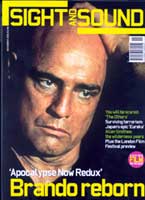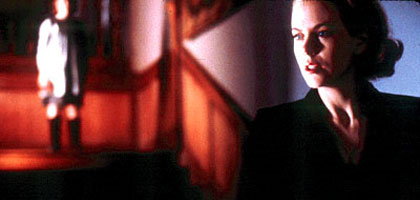
Dread Again

The devil is in the details of The Others, Alejandro Amenábar's Turn of the Screw-style horror. But Nick James refuses to shed light on what's spooking Nicole Kidman.
To give nothing away, that's the trick. Ghost stories don't want harbingers of their particular doom. Not if they're as sheet-smooth as Alejandro Amenábar's The Others (Los Otros). Not when they're thrillingly orchestrated to scare the bejeezus out of the most self-consciously cool customer. With all its fright springing from that epitome of creaking set-ups, the haunted house, The Others earns every hair it stiffens. Therefore, giving it due respect, this article will tell you something of what happens, but offer only the slenderest hint as to what reallyhappens.
Who'd have thought that things could still go bump in the night and render 21st-century sophisticates witless with terror? Who'd have believed that the uncanny in its most moth-eaten Miss Havisham clothes could still put the willies up the sated, seen-it-all modern moviegoer? The Others does this despite our foreknowledge of all things ghostly. As in many another haunted house, the occupants of this stately pile may glide as ineluctably as fate or flee in thundering boots down passages that groan with quality timber. Yet the film's grip on our attention remains as tight as a rigored fist.
It's a big, exaggerated old house, a lot like the generic horror house of Hollywood's prime, a labyrinthine honeycomb of interconnecting high-ceilinged rooms - each of which must be locked at all times for reasons I will soon divulge. Discreetly, though, it's also an up-to-date manifestation: the setting is the island of Jersey in 1945 and the heavy furnishings are late Victorian, but neither the British taste for claustrophobia-inducing clutter nor our nostalgic yen for 40s wartime memorabilia has been over-indulged. It's not quite the Victorian country house laid bare, as in a modern stage set, but it wouldn't look out of place in a light-filled photo book called, say, Victorian Gothic Style - especially if you removed the photographs of the family, including the missing father in his army uniform. But then, as you will soon discover, you would also have to remove the family itself.
The chief occupant is Grace, a precise and tidy young woman - that's why she's so distraught at the disappearance of the servants. She has her reasons to banish clutter, which is particularly treacherous underfoot in her household. She holds to a rigorously topsy-turvy routine designed for one purpose: to encourage the gloom that conceals stray toys on staircases, to shut out the very light that would make her home a lovely picture-book essay in empire exultance. For Grace, darkness is a shield, because her two children, the small, vulnerable and imaginative Nicholas and his distant and seemingly imperturbable elder sister Anne, are allergic to daylight. Hence the locked rooms in case the children should stray into a blistering roomful of sunrise.
That's why Grace needs new servants despite the wartime shortage of labour. And she soon has them. A staunch and tolerant housekeeper, Mrs Mills, a grave and respectful gardener, Mr Tuttle, and a young ladies' maid, Lydia (who has lost the power of speech), arrive to answer her call and are soon bending to her every whim, no matter how unreasonable. And Grace can be a fearsome martinet of an employer, a person from less fastidious times than ours who treats her underlings as underlings (without losing our sympathy for her). They, in turn, understand, perhaps as we do, that Grace is just one of many young war widows who cannot bear to tell her children that the war is over and their father is not coming back, ever.
We don't know what kind of trauma Grace may have undergone under the Nazi occupation. Jersey has been the focus of a number of agonised books about its inhabitants' behaviour: a concentration camp was built and used in the Channel Islands and some murky collaboration went on between British citizens and the German occupiers. But this is not at issue here. Jersey in this film is just a remote spot where something terrible has happened, something Grace seems desperate to suppress.
Grace's natural restraint and need for control echo the film's own. The Others never wants to flag its special effects the way Robert Zemeckis couldn't resist doing in What Lies Beneath (2000). There's no sense here of an escalation of resources - when Amenábar wants to scare you he's more likely to take something away than to add it. And it's the same with character. The Others doesn't give Grace any backstory. She doesn't have her curiosity roused by vengeful ghosts as Michelle Pfeiffer's cheated wife does in What Lies Beneath. Curiosity is her enemy. Her fright-white blanknesss is what keeps the spoofiness - let's call it that Arsenic and Old Lace feeling - at bay. In spoof's place is a heightened sense of the eerie. Even bearing in mind her children's condition, Grace's unexplained nervousness seems almost overwrought, and the children, particularly Anne, seem otherworldly to the point of near-erasure, in touch with an uncanny dimension that's hidden as much from us as from Grace.
Which is another way of saying that there's a strong dose of Henry James about The Others. Grace is a sister creation to Deborah Kerr's governess Miss Giddens in The Innocents (1961), Jack Clayton's brilliantly febrile adaptation of James' The Turn of the Screw. The conflict in Clayton's film is between the sexually repressed governess and the children she believes to be possessed, most likely (though James would never think such a thing, let alone spell it out) because she suspects they are influenced by sexual beings - the dead couple, the former governess and her groundsman lover - and that they commune with these beings through their own burgeoning wickedness. Kerr plays the governess as if she is being slowly imprisoned by the alarming power of her own imagination, whereas Nicole Kidman's Grace is corseted by her challenged beliefs: she's deeply religious in a strict Catholic, disciplinarian fashion and punishes her children when they start to tell her about things she doesn't want to believe - even when her own acute senses present them to her incontrovertibly.
But while the Clayton-Jamesian atmosphere is an obvious referent, the two protagonists' situations are quite different. Giddens is a surrogate mother who sublimates her romantic longings for the absent parent she's met but once into her relationship with her two charges. Grace's hysterical need to keep the truth of their father's death from her children prevents her trusting her own intelligence as well as her motherly instincts. In other words, Miss Giddens fears that her demons are within whereas Grace fears external knowledge.
In any case, Kidman's fever-pitch performance makes its own difference. The Englishwoman she characterises is like a movie hybrid that's simultaneously strange and familiar. Brief Encounter's super-repressed Celia Johnson is in there, as is Vivien Leigh at her most brittle, but there's also some of the elegant sweep and defiance of Grace Kelly (hence, one supposes, the name Grace). Kidman seems to nail everything Hitchcock fantasised about cool blondes with hidden fire while at the same time exposing the confusion of an educated woman left with too much time on her hands and nothing to do but watch the children. Peter Wollen noted that what he enjoyed most about Kidman in Baz Luhrmann's Moulin Rouge is that she seemed so relaxed, so much her Australian self in contrast with the hyper-neurotic roles she often plays. Here she's back on her nerve endings but at the point where seemingly genuine feeling shifts brilliant technique to a higher level. This is an actress at the peak of her powers and very much a modern movie star to rival Kelly in glamour and Johnson in technique. She's joined by the kind of character actors that once enhanced the pleasure of every Hollywood film. Fionnula Flanagan as Mrs Mills and Eric Sykes as Mr Tuttle manage to deliver the most shamelessly corny lines in a way that enhances the sense of a truly dreadful secret about to be exposed. The Others is as much an ensemble triumph as one of cinematic craft.
Previously known only for two flashily stylish Spanish features that had a limited impact in the UK - the snuff-movie thriller Thesis (Tesis, 1995) and the sexual-revenge odyssey Open Your Eyes (Abre los ojos, 1997) - Alejandro Amenábar has erupted into mainstream international film-making presumably because Tom Cruise is remaking Open Your Eyes in English under the title Vanilla Sky as a vehicle for himself and Penélope Cruz. On the evidence of The Others, on which Cruise was an executive producer, Amenábar is potentially a major talent in the M. Night Shyamalan mould. There's a similar sense of absolute control over a script of delicate narrative sleights of hand to the point where it's arguable that The Others shows even greater parsimony than, say, Shyamalan's Unbreakable in the way it drip feeds its revelations through its marshalling of mise en scène.
The Others is a Spanish production in the sense that it was shot in Spain and uses the finest of Spanish and Hollywood craftspeople. I would single out director of photography Javier Aguirresarobe for his Stygian sense of gloom, producing chiaroscuro-steeped images that wouldn't look out of place in the Prado; Hollywood veteran production designer Benjamín Fernández for the magnificent house; and most of all Isabel Díaz Cassou for her superbly creepy sound design.
Last year's Donostia-San Sebastian film festival showed a Spanish version of James' The Turn of the Screw called Presence of Mind (El celo), directed by Antoni Aloy and itself set on an island. It starred Sadie Frost as the governess and Lauren Bacall as the (Spanish) housekeeper. As a measure of how James' text can be milked for terrible gothic grandstanding, Presence of Mind was exemplary. It was impossible then to imagine something as superbly in contrast as The Others. Now, at a time when so much mainstream film-making in Hollywood has had to be put on hold, there should be more room for films like The Others, films with the qualities of Hollywood's golden age, superb genre pieces that exhibit restraint, spareness and gradualism.
